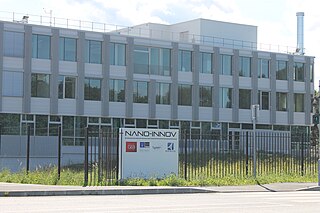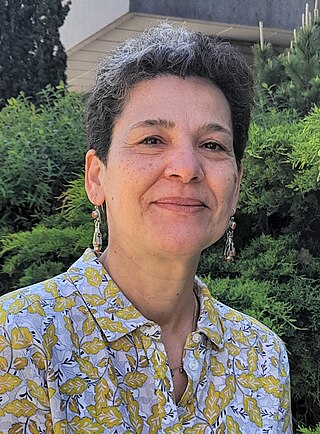Related Research Articles

STMicroelectronics NV is a multinational corporation and technology company of French-Italian origin. Incorporated in the Netherlands, its headquarters are in Plan-les-Ouates, Switzerland and it is listed on the New York Stock Exchange, the Euronext Paris and the Borsa Italiana in Milan. ST is the largest European semiconductor contract manufacturing and design company. The company resulted from the merger of two government-owned semiconductor companies in 1987: Thomson Semiconducteurs of France and SGS Microelettronica of Italy.

The French Alternative Energies and Atomic Energy Commission, or CEA, is a French public government-funded research organisation in the areas of energy, defense and security, information technologies and health technologies. The CEA maintains a cross-disciplinary culture of engineers and researchers, building on the synergies between fundamental and technological research.
Soitec is an international company based in France, that manufactures substrates used in the creation of semiconductors.

The Université Grenoble Alpes is a public research university and a grand établissement in Grenoble, France. Founded in 1339, it is the third largest university in France with about 60,000 students and over 3,000 researchers.

Joseph Sifakis is a Greek-French computer scientist. He received the 2007 Turing Award, along with Edmund M. Clarke and E. Allen Emerson, for his work on model checking.

CEA-Leti is a research institute for electronics and information technologies, based in Grenoble, France. It is one of the world's largest organizations for applied research in microelectronics and nanotechnology. It is located within the CEA Grenoble center of the French Alternative Energies and Atomic Energy Commission (CEA).
Adrian Mihai Ionescu is a Romanian and Swiss physicist and academic. He is full Professor at the Swiss Federal Institute of Technology in Lausanne (EPFL), where he is founder and director of the Nanoelectronic Devices Laboratory.
Dawon Kahng was a Korean-American electrical engineer and inventor, known for his work in solid-state electronics. He is best known for inventing the MOSFET, along with his colleague Mohamed Atalla, in 1959. Kahng and Atalla developed both the PMOS and NMOS processes for MOSFET semiconductor device fabrication. The MOSFET is the most widely used type of transistor, and the basic element in most modern electronic equipment.
The IEEE International Electron Devices Meeting (IEDM) is an annual micro- and nanoelectronics conference held each December that serves as a forum for reporting technological breakthroughs in the areas of semiconductor and related device technologies, design, manufacturing, physics, modeling and circuit-device interaction.
Tamara Macushla Munzner is an American-Canadian scientist. She is an expert in information visualization who works as a professor of computer science at the University of British Columbia (UBC).
Clinatec is a biomedical research center based at the Polygone Scientifique in Grenoble. Doctors, biologists and micro- and nanotechnology experts work side by side at the 6,000 m2 facility. Around a hundred researchers and employees work at the center. When it opened at the end of 2011, it was hailed as the first center of its kind in the world. With six hospital rooms, cutting-edge medical imaging equipment and an operating suite, Clinatec was developed by the Research Division of the CEA, Grenoble-Alpes University Hospital (CHU), Inserm and the Université Grenoble Alpes. The primary focus is on cancer, neurodegenerative diseases and disability.

CEA-List is one of three institutes of the French CEA technological research division CEA Tech. The institute specializes in digital systems. It has the Carnot label.
Gerard Ghibaudo is an electrical engineer with IMEP-LAHC, part of the Grenoble Institute of Technology in Grenoble, France. He was named a Fellow of the Institute of Electrical and Electronics Engineers (IEEE) in 2013 for his contributions to electron device characterization and modeling.
Bernt Schiele is a German computer scientist. He is Max Planck Director at the Max Planck Institute for Informatics and professor at Saarland University. He is known for his work in the field of computer vision and perceptual computing.
Roya Maboudian is an American academic and researcher in the field of chemical engineering. She is professor of chemical and biomolecular engineering at the University of California, Berkeley. She is a co-director of the Berkeley Sensor and Actuator Center, and an editor of the IEEE Journal of Microelectromechanical Systems. She was one of the first women to earn tenure in the chemical engineering department at the University of California, Berkeley.
Alice Elizabeth White is an American physicist. She is a professor and chair at the Boston University College of Engineering. Previously, she was Chief Scientist at Bell Labs. She is a fellow of the APS, the IEEE and the OSA.
Weebit Nano is a public semiconductor IP company founded in Israel in 2015 and headquartered in Hod Hasharon, Israel. The company develops Resistive Random-Access Memory technologies. Resistive Random-Access Memory is a specialized form of non-volatile memory (NVM) for the semiconductor industry. The company’s products are targeted at a broad range of NVM markets where persistence, performance, and endurance are all required. ReRAM technology can be integrated in electronic devices like wearables, Internet of Things (IoT) endpoints, smartphones, robotics, autonomous vehicles, and 5G cellular communications, among other products. Weebit Nano’s IP can be licensed to semiconductor companies and semiconductor fabs.
Bernard Dieny is a research scientist and an entrepreneur. He is Chief Scientist at SPINTEC, a CEA/CNRS/UGA research laboratory that he co-founded in 2002 in Grenoble, France. He is also co-founder of two startup companies: Crocus Technology on MRAM and magnetic sensors in 2006 and EVADERIS on circuits design in 2014.
Jocelyne Troccaz is a French roboticist and researcher in medical imaging and image-guided robotics. She is a director of research for the French National Centre for Scientific Research (CNRS), affiliated with the Computer-Assisted Medical Interventions team (GMCAO) of the Laboratory for Translational Research and Innovation in Medicine and Complexity (TIMC) at Grenoble Alpes University. After originally specializing in industrial applications of robotics, her interests shifted to medical robotics.

Faïrouz Malek also known as Faïrouz Ohlsson-Malek is a French and Algerian physicist specializing in nuclear physics, particle physics and cosmology. A research scientist at the French National Centre for Scientific Research, she is involved in international research at the CERN LHC. She has contributed to the discovery of the Higgs boson. She is also known for her commitment to gender parity in science, as well as to the development of science in Africa. She is fellow of the African Academy of Sciences. She is the niece of Algerian composer Ahmed Malek.
References
- 1 2 3 "Biography Barbara De Salvo, PhD", Fellow scientists, CEA-Leti, 27 February 2017, retrieved 2023-05-10
- ↑ "Barbara De Salvo", Theses.fr, retrieved 2023-05-10
- ↑ "Abstracts and biographies", Connecting Heterogeneous Systems Summit, SEMI, September 2021, retrieved 2023-05-10
- ↑ 2020 Newly Elevated Fellows (PDF), IEEE, archived from the original (PDF) on 2019-12-04, retrieved 2023-05-10